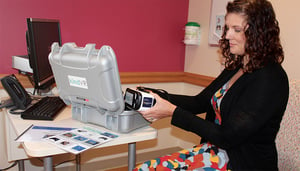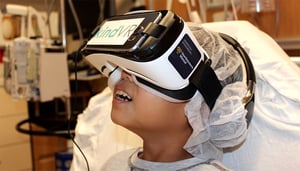
For children with cancer or blood disorders, virtual reality may be an effective way to reduce anxiety and distress
All around Emanuel Monge was bright blue water and rainbow-colored fish. Smiling sea lions passed by, as gray whales soared overhead. Dancing dolphins bobbed above an array of artifacts from a shipwreck long ago.
The 13-year-old glided through the ocean, taking in the sights and sounds surrounding him. He flung balls at fish, discovering that the contact zapped them into neon colors. He learned if he launched enough balls, he’d get an ancient column to topple over to the ocean floor.
After a few more minutes of looking around and playing, his boat suddenly came into view. The next thing he knew he was back to where he had been: the MACC Fund Center for Cancer and Blood Disorders at Children’s Wisconsin.
Emanuel’s underwater adventure had been a virtual reality experience offered to him as a way to ease his anxiety during a transfusion.
“He loved it,” said his mom, Veronica Monge. “It was just so realistic, and he was able to get his mind off what was happening at the moment.”
Emanuel was one of about 20 patients who tried out virtual reality over the summer. All the patients were from the MACC Fund Center for Cancer and Blood Disorders, an area of our hospital that provides oncology, hematology and blood disorder treatment.
Researching the effectiveness of virtual reality
 Jenny Hoag, a pediatric psychologist in the MACC Fund Center for Cancer and Blood Disorders, led the initiative as a first step in studying the effectiveness of virtual reality in calming patients.
Jenny Hoag, a pediatric psychologist in the MACC Fund Center for Cancer and Blood Disorders, led the initiative as a first step in studying the effectiveness of virtual reality in calming patients.“I work with a lot of patients who have anxiety and distress over procedures involving needles,” Dr. Hoag said. “They’re distressing, scary and sometimes painful, so I’m always looking for ways to manage that.”
Thus, Dr. Hoag was immediately on board earlier this year when Northwestern Mutual, a generous supporter of Children’s Wisconsin, presented an opportunity to use virtual reality.
“There is some data to suggest that virtual reality can be effective in other populations like burn patients, so we wanted to see if it would work here for our patients in the MACC Fund Center for Cancer and Blood Disorders,” Dr. Hoag said.
The kids who used virtual reality over the summer participated in what Dr. Hoag called a “pre-study look.” She wanted to test its feasibility and to ensure the patients — many of whom suffer from nausea — would be able to withstand it.
“We learned that it was well-tolerated, and the kids described it as exciting and fun. It was very well-accepted,” she said.
To undergo the virtual reality experience, the patients wear a pair of goggles and headphones made by a California-based company called KindVR. They are also given a video game-like controller that allows them to shoot balls at objects.
When kids get anxious, procedures can get delayed
 In the coming months, Dr. Hoag will begin a research project funded by a Northwestern Mutual grant that will compare virtual reality with guided imagery. The current standard of care for coping with procedural distress, guided imagery involves setting a relaxing scene for a patient through verbal descriptions and audio.
In the coming months, Dr. Hoag will begin a research project funded by a Northwestern Mutual grant that will compare virtual reality with guided imagery. The current standard of care for coping with procedural distress, guided imagery involves setting a relaxing scene for a patient through verbal descriptions and audio.“We want to know if the more immersive components of virtual reality benefit patients in additional ways when it comes to anxiety and pain,” said Dr. Hoag, who serves as the principal investigator.
For the study, both the virtual reality and guided imagery experiences will consist of a 15-minute underwater scenario. Once the patient is acclimated to the scene, the nurse will enter the room and complete the procedure.
“The goal is to see if one makes the procedure go faster,” Dr. Hoag said. “A lot of procedures get delayed because the kids are anxious. They’ll hide under the exam table or refuse to put their arm out.”
Dr. Hoag and her co-investigators plan to conduct the year-long study with 50 patients who will experiment with each intervention. Afterwards, the children will have the opportunity to give the research team their feedback.
Although the parents will not participate in either intervention, they will also fill out a questionnaire about their experience in the room, as many parents experience distress while watching their children undergo procedures.
The patients will range in age from 8 to 25, and the only requirement to participate is that the patients must have been diagnosed for at least a month.
“There’s some theories that suggest the more distracted you are and the more immersed you are in an imaginary scenario, the less likely your brain will process pain and anxiety,” Dr. Hoag said. “My hypothesis is that virtual reality will be more beneficial.”
If virtual reality proves to be a more beneficial and cost-effective intervention, it’s possible it could be implemented in other areas of the hospital.
“I really want to demonstrate which one is better,” Dr. Hoag said of virtual reality and guided imagery. “Whatever intervention it is, I want to know it is empirically supported and that we are doing the things we know work the best for our patients in reducing distress.”
Children's Wisconsin Resources
Written by
Hilary Dickinson
Writer



